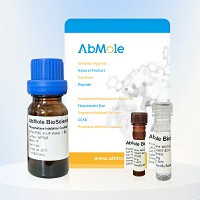All AbMole products are for research use only, cannot be used for human consumption.

Species: Mouse
Expression system: E.coli
Purity: > 95% as determined by reduced SDS-PAGE
Endotoxin: less than 0.001 ng/ug (0.01 EU/ug) as determined by LAL
Storage and stability: storage temperature ≤-70℃, after receiving the goods can be stably stored for 6 months. After opening, store in aseptic condition for 3 months, storage temperature ≤-70℃. Please minimize freeze-thaw cycles.
Bioactivity: Fibroblast growth factor-9 (FGF-9) is a glycoprotein of the FGF-family secreted about 26 kDa. Secreted mouse FGF-9 lacks n-terminal 1-3-AA and shares >98% sequence consistency with FGF-9 of rats, humans, horses, pigs and cattle. Fgf-9 plays an important role in regulating embryonic development, cell proliferation, cell differentiation and cell migration. In embryonic mice, FGF expression - 9 position and time affect bones, cerebellum, lungs, heart, blood vessels, gastrointestinal tract and testicular development, may in the development of glial cells in the process of growth and differentiation, in the process of repair and regeneration after injury of brain tissue glial cell proliferation, differentiation and survival of neurons, and glial tumor growth stimulation and so on. Fgf-9 deletion in mice is fatal at birth due to lung hypoplasia and leads to root-like protuberances or shortening of proximal bones. An unusual compositional dimer of FGF 9 obsures the receptor's interaction site, thereby reducing its activity and increasing the affinity of heparin, thereby inhibiting diffusion. Eks, a spontaneous mutant in mice, interferes with dimerization and produces monomer, diffusible FGF-9. Misexpression of FGF-9 in developing joints leads to elbow and knee slippage (joint fusion).
| Storage |
Powder -20°C 3 years ; 4°C 2 years In solvent -80°C 6 months ; -20°C 1 month |
| Related Cytokines and Growth Factors Products |
|---|
| Recombinant Human GDF-15 Protein (HEK293 N-hFc)
Growth-differentiation factor 15 (GDF15), also known as MIC-1, is a secreted member of the transforming growth factor (TGF)-β superfamily. GDF-15 has a role in regulating inflammatory and apoptotic pathways in injured tissues and during disease processes. GDF-15 overexpression arising from an expanded erythroid compartment contributes to iron overload in thalassemia syndromes by inhibiting hepcidin expression. |
| Recombinant Human FGFR1 Protein (HEK293, C-His)
FGFR1, also known as CD331, is a full-length representative protein consists of an extracellular region, composed of three immunoglobulin-like domains, a single hydrophobic membrane-spanning segment and a cytoplasmic tyrosine kinase domain. |
| Recombinant Human FGFR2 Protein (HEK293, C-His)
FGFR2, also known as CD332, acts as cell-surface receptor for fibroblast growth factors and plays an essential role in the regulation of cell proliferation, differentiation, migration and apoptosis, and in the regulation of embryonic development. FGFR2 plays an essential role in the regulation of osteoblast differentiation, proliferation and apoptosis, and is required for normal skeleton development. It also promotes cell proliferation in keratinocytes and imature osteoblasts, but promotes apoptosis in differentiated osteoblasts. |
| Recombinant Mouse BMP-4 Protein (E. coli, C-His)
Bone Morphogenetic Protein-4 (BMP-4) is a critical signaling molecule required for the early differentiation of the embryo and establishing of a dorsal-ventral axis. BMP-4 is secreted from the dorsal portion of the notochord, and it acts in concert with sonic hedgehog to establish a dorsal-ventral axis for the differentiation of later structures. |
| Recombinant Human Coagulation Factor X (HEK293, C-Fc)
Coagulation factor X, belongs to the peptidase S1 family. Coagulation factor X is initially synthesized in the liver. Coagulation factor X is a vitamin K-dependent glycoprotein that converts prothrombin to thrombin in the presence of factor Va, calcium and phospholipid during blood clotting. |
All AbMole products are for research use only, cannot be used for human consumption or veterinary use. We do not provide products or services to individuals. Please comply with the intended use and do not use AbMole products for any other purpose.


Products are for research use only. Not for human use. We do not sell to patients.
© Copyright 2010-2024 AbMole BioScience. All Rights Reserved.
